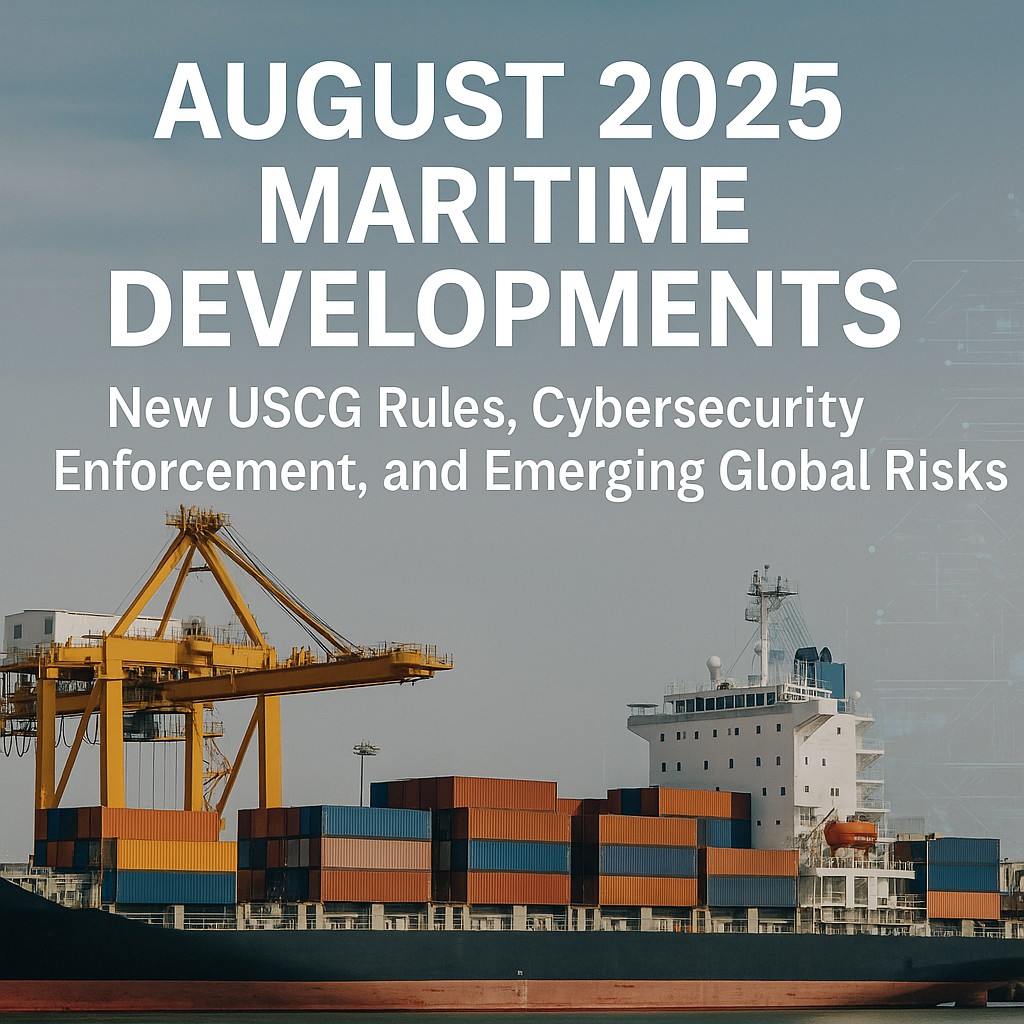As we moved into August 2025, the maritime sector experienced several pivotal shifts—regulatory updates around alternative fuels, cybersecurity enforcement entering into effect, and port throughput dynamics continuing to adjust from July’s container surge. This post unpacks the “August 2025 maritime developments” you need to know, with an eye towards security, compliance, and resilience.
New USCG Guidelines for Alternative Fuel Bunkering
Just before August began, the U.S. Coast Guard released Policy Letter CG-OES 01-25, effective July 24, 2025, updating guidelines for bunkering vessels using LNG and other alternative marine fuels. This supersedes two older policy letters from 2015.
Under these updated rules, no transfer may proceed without a prior risk assessment.
Implications & risk angles:
- Fuel bunkering infrastructure must now incorporate strict risk assessment protocols—both to prevent spills and to manage safety in dual-fuel operations.
- Facilities and terminals must ensure compliance tracking, documentation, and potentially third-party auditing.
- From a cybersecurity/OT perspective, interfaces between bunkering control systems and SCADA/OT networks will come under greater scrutiny.
Cybersecurity Rule Enforcements & Reporting Obligations
Although the Coast Guard’s cybersecurity framework officially took effect on July 16, 2025, August is the first full month where regulated entities must adapt to its compliance requirements.
Key obligations include:
- Reporting certain cyber incidents to the National Response Center (NRC)
- Designating a Cybersecurity Officer
- Implementing governance, training, and oversight structures
- Enforcing these obligations is now no longer optional — they carry legal, operational, and reputational risk.
For maritime operators, August becomes the test period: any misstep (missed reporting, incomplete response plans, or weak internal controls) could trigger enforcement actions or liability.
Port Throughput & Shipping Trends Continue Adjusting
While July’s import surge grabbed headlines, early August signals shifts in port dynamics and throughput patterns. According to shipping analysts:
- U.S. West Coast ports regained some momentum, easing congestion that overwhelmed them in July.
- Container shipping news for August anticipates a cooling in volume growth, citing overcapacity and diverted routes from Red Sea pressures.
- Asia–U.S. trade lanes continue seeing reroutes to avoid conflict zones, elevating fuel, schedule, and operational risk.
These shifts mean that August is a pivotal month for logistics providers, port operators, and carrier planners: how you manage changing flows may determine whether you gain or lose ground in the next quarter.
Shadow Fleets, Sanctions & Covert Risk
Stepping into August, another quietly escalating trend is the role of shadow fleets and ambiguous maritime assets in geopolitical strategies. A recent analysis by U.S. Naval Institute describes how shadow fleets—commercial vessels operating under opaque ownership, registry, or financing structures—are increasingly used in sea denial and asymmetric naval strategy.
Risks tied to shadow fleets:
- Difficulty in attribution in sanctions enforcement or regulatory jurisdiction
- Exposure in supply chains if subcontracted services unknowingly interact with such vessels
- Potential for mixed-use operations (commercial + covert) leading to legal/regulatory exposure
For maritime compliance, the growing prominence of shadow fleets demands tighter due diligence on vessel identity, ownership, flag, and financial trails.
Migrant & Humanitarian Maritime Tragedies
Early August also revealed the tragic underlying forces crossing maritime peripheries. On August 3, 2025, a boat carrying 154 migrants/refugees from Ethiopia capsized off the Yemeni coast, resulting in a high number of fatalities.
While not purely a commercial shipping concern, these tragedies highlight the maritime safety, search & rescue (SAR), and humanitarian dimensions of seaborne movement—especially near conflict zones and distressed nations. Any maritime security strategy must account for these real-world human risks, both morally and operationally.
Conclusion
The first week and days of August 2025 may not carry the dramatic headline events of war or catastrophe—but they represent a convergence zone: regulation (bunkering, cyber), shifting logistics patterns, emerging covert risk dynamics, and maritime safety in vulnerable regions. Together, they make clear that resilience in shipping now demands vigilance on multiple fronts.
Stay ahead of the tide.
Partner with maritime risk and cybersecurity experts to audit your bunkering protocols, shore-to-vessel cyber defenses, and vessel roster compliance. The Saturn Partners is here to help ensure you are safe guarded from vulnerabilities. The more prepared you are, the more you secure not just operations—but your reputation and future.

